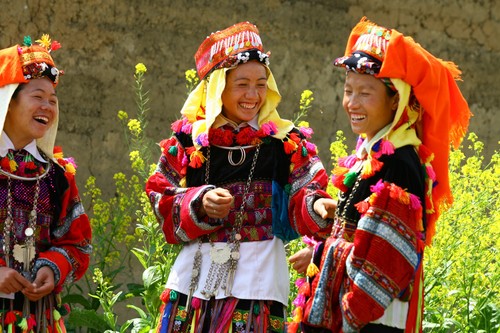The Yao people (simplified Chinese: 瑶族; traditional Chinese: 瑤族; pinyin: Yáozú) or Dao (Vietnamese: người Dao) is a classification for various ethnic minorities in China and Vietnam. Their majority branch is also known as Mien. They are one of the 56 officially recognized ethnic groups in China and reside in the mountainous southwest and south of the country. They also form one of the 54 ethnic groups officially recognized by Vietnam. They numbered 2,796,003 in the 2010 Chinese census and 891,151 in the 2019 Vietnamese census. An estimated 60,000 Yao of the Iu Mien branch reside in the United States, mostly in the Western coastal states.
History
China
The origins of the Yao can be traced back two millennia to Hunan around the Dongting Lake region. According to a Yao tale, the Chinese Emperor Gao Xin was saved from an enemy chieftain by his faithful dog, Pan Hu. As a reward, Pan Hu was turned into a man and given the emperor’s daughter in marriage. The descendants of the two became the Yao people. This tale was used as a basis for their connection to the Mo Yao, a group of highlanders who were exempt from forced labour during the Tang dynasty (618-907). Between 200 BCE and 900 CE, the Yao migrated into mountainous areas to the south of the Yangtze River.
The Yao were conquered by the Han Chinese between the 900s and 1200s. However they were covered under a loose reign system known as the Jimi system or Tusi. The local chieftains collected tribute and taxes from their own people and paid taxes to the emperor.
During the Ming and Qing dynasties, rule over the Yao was tightened. Ming and Qing authorities sent in their own bureaucrats to directly collect taxes, supplanting the role of the Yao chieftains.[5] The Yao and Miao people were among the rebels during the Miao Rebellions against the Ming dynasty during the 1370s and 1449. Conflict drove the Yao further south into the highlands between Hunan and Guizhou to the north and Guangdong and Guangxi to the south, and stretching into Eastern Yunnan. Some left for Southeast Asia.
Around 1890, the Guangdong government started taking action against Yao in Northwestern Guangdong.
After the Mao Zedong’s Communist Party won the civil war in the late 1940s, the Yao benefited greatly from the ideology of equality and were able to access education, becoming part of the regional and national elite. They were often recruited as specialists to assist with the ethnic identification program within the framework of a large unified China.
Laotian Civil War
During the Laotian Civil War, the Yao tribes of Laos had a good relationship with U.S. forces and were dubbed to be an “efficient friendly force”. They fought in favour of the (South Vietnamese) government against the communists. This relationship caused the new communist Laotian government to target Yao tribal groups once the war was over. This triggered further immigration into Thailand, where the tribes would be put into camps along the Thailand-Laos border.
Immigration to the United States
After obtaining refugee status from the Thai government, and with the help of the United Nations, many Yao people were able to obtain sponsorship into the United States (although many remain in Thailand). Most of the Yao who have immigrated to the United States have settled along the Western part of the US, mainly in central and northern California such as Visalia, Oakland, Oroville, Redding, Richmond, Sacramento, but also in parts of Oregon like Portland, Salem, and Beaverton as well as the state of Washington in Seattle and Renton. See Mien American for those identified as Mien.
Culture, society, and economy
Yao society is traditionally patrilineal, with sons inheriting from their fathers. The Yao follow patrilocal residence. Polygyny was allowed until it was banned in China in the 1950s. Adoption was common among the wealthy.
The Yao people have been farmers for over a thousand years, mostly rice cultivation through plowing, although a few practice slash-and-burn agriculture. Where the Yao live nearby forested regions, they also engage in hunting.
During the Southern Song (1127–1279), an imperial Chinese observer, Zhou Qufei, described the Yao as wearing distinctive fine blue clothing produced using indigo.
The Yao celebrate their Pan Wang (King Pan) festival annually on the sixteenth day of the tenth lunar month. The festival celebrates the mythical original story of the Yao people, and has evolved “into a happy holiday for the Yao to celebrate a good harvest and worship their ancestors.
Religion
The description of Yao religion is similar to the definition of Chinese folk religion as described by Arthur Wolf and Steve Sangren. Like the Han, the Yao engage in patrilineal ancestor worship, celebrate lunar new year, and recognize a set a 18 gods and goddesses, mostly of Han Chinese origin. The Yao had shaman priests as part of their community who engaged in activity such as exorcism, spiritual communication, and divination using chicken bones or bamboo sticks.
Taoism has historically been important to the Yao. Jinag Yingliang, in a 1948 study, argued that Yao religion was characterized by a process of Han Chinese-influenced Daoisation (Chinese: 道教化; pinyin: Dàojiào huà); the endurance of pre-Daoist folk religion; and some Buddhist beliefs.
Scholar Zhang Youjun takes issue with claims of “strong Buddhist influence” on the Yao, arguing that “although Yao ritual texts contain Buddhist expression, the Yao do not believe in Buddhism at all. They are resolutely Taoist.
source: https://en.m.wikipedia.org/wiki/Yao_people

